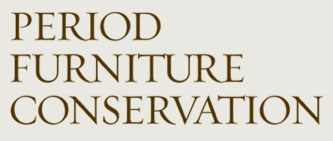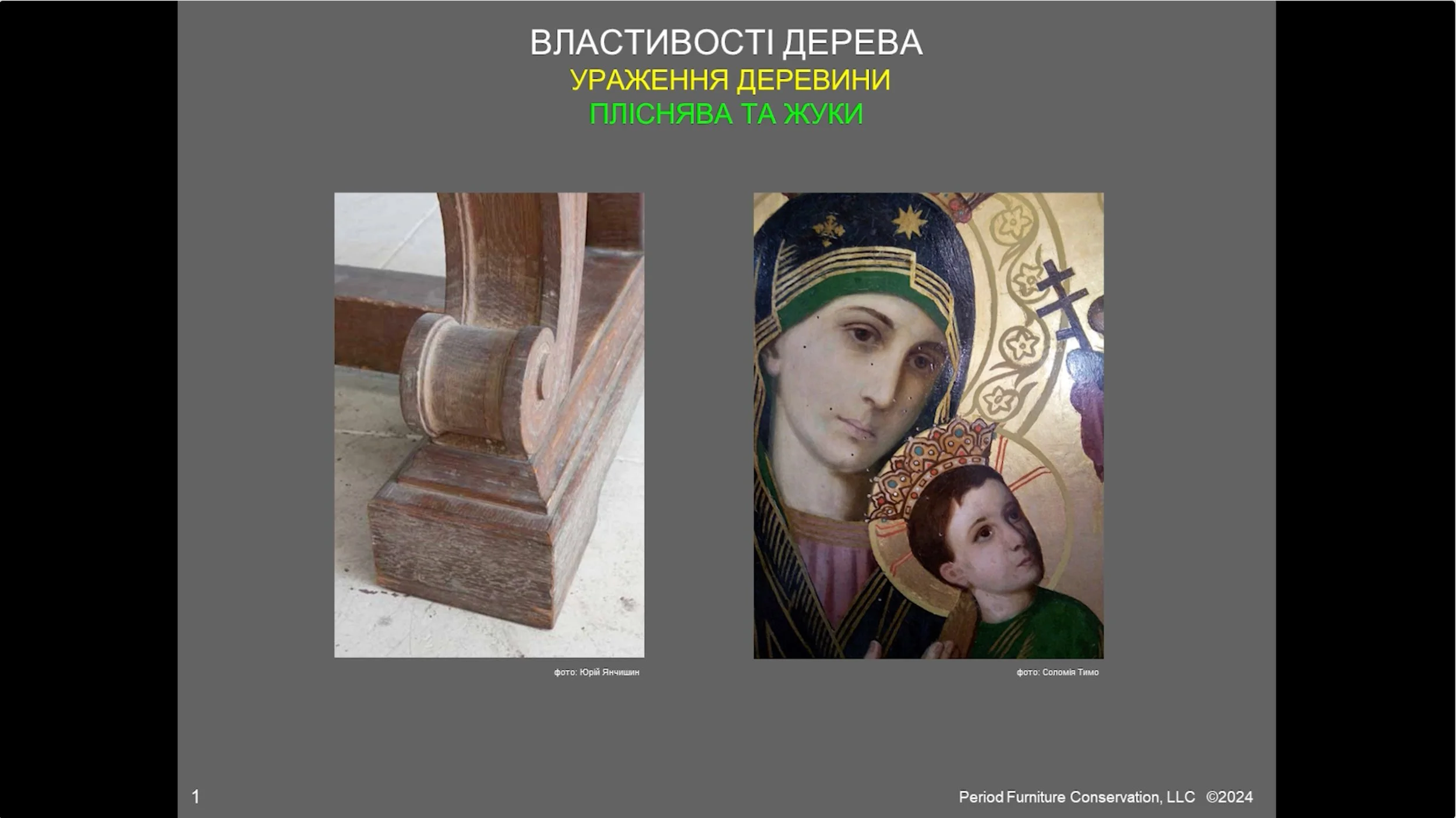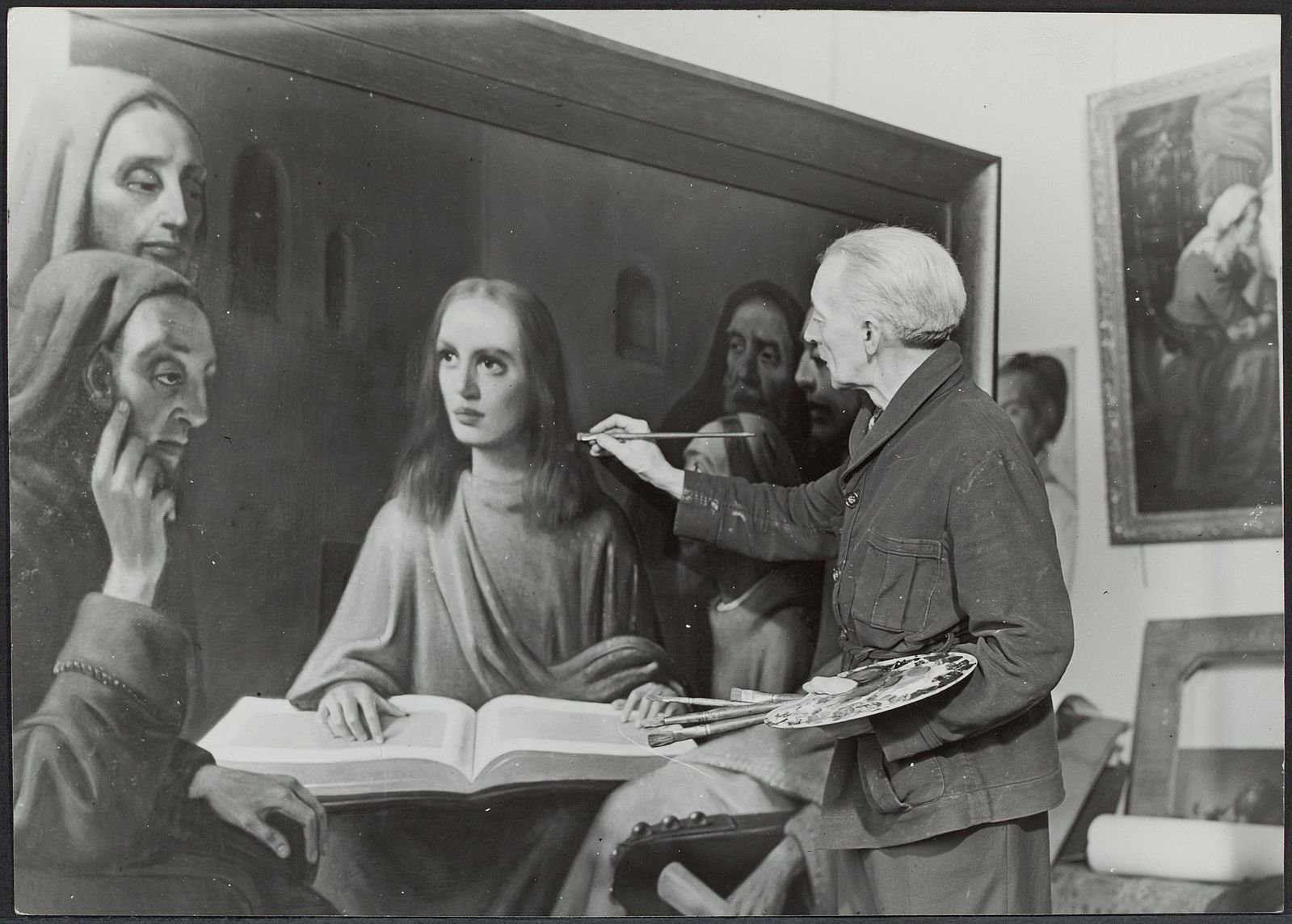On May 30, 2025 Yuri Yanchyshyn presented a talk at the American Insitute for Conservation Yearly Meeting, entitled “Furthering Conservation in Wartime Ukraine.” In his talk he introduces the 20c history of conservation science and the treatment of objects in Ukraine, as a necessary context for understanding the post WWII Soviet era and today’s efforts to preserve Ukraine’s cultural heritage during the current war.
On January 27, 2025, Yuri Yanchyshyn gave the Annual General Meeting Talk at the International Institute for Conservation in London, entitled Conservation in Wartime Ukraine - Context, Challenges, Opportunities. This presentation, given by an AIC Wooden Artifacts conservator, Fulbright Specialist, and Scholar to Ukraine before the war, introduced the attendees to the objects and dedicated individuals who cared for this heritage while providing an integral 20c historical context. It concluded by assessing the wartime situation today and outlined pathways for the future.
“Yuri Yanchyshyn, a conservator of wooden artifacts and a researcher and scholar, has been volunteering with the project. He recalled being “dumbfounded” the first time he entered a wooden tserkva. The churches are an example of vernacular, or folk architecture, he said, built by local parishioners and craftsmen. Many have no nails and are held together with either pegs or mortise and tenon joinery. “
On October 3, 2024, Yuri Yanchyshyn, Fulbright Specialist and Scholar, gave a Ukrainian language presentation on “An Introduction to the Microscopic Wood Identification of Works of Art” at the Lviv Polytechnic National University in Lviv, Ukraine. This lecture builds on the knowledge presented during his lecture on “The Structure and Properties of Wood” of February 4, 2024. A handout accompanying this talk is available here
A highly detailed wood identification report (in Ukrainian) of a period icon from the Andrey Sheptytsky National Museum in Lviv, outlining the step-by-step wood identification procedures involved, is available here
On October 3, 2024 the Ukrainian language edition of The Conservation of Medieval Polychrome Wood Sculpture was presented at the Lviv Book Forum. Originally written by Michelle Marincola and Lucretia Kargere, the book was published to wide acclaim by Getty Publications in 2020. The presentation was hosted at the National Museum of Andrij Sheptytsky in Lviv, Ukraine, by Oksana Bila. It brought together Lydia Lykhach, the Chief Editor of RODOVID Press (the Ukrainian language publisher), the translation editorial team, and guests.
On May 27, 2024, Yuri Yanchyshyn delivered this presentation as part of a Ukrainian Institute and other organizations sponsored three day conference in Berlin, entitled “From Crisis To Future: New Responsibilities for Museums in Ukraine.” Further information regarding the conference can be found at the following link https://obmin.eu/conference.php
ЗАМИЛЕНЕ ОКО ПРОТИ ДОСВІДЧЕНОГО ― МЕБЛЕВЕ ШАХРАЙСТВО ТА ПРОБЛЕМИ ЗБЕРІГАННЯ
23 травня 2024 року, Юрій Янчишин прочитав лекцію на тему "Замилене Око проти Досвідченого - Mеблеве Шахрайство та Проблеми Зберігання" для Міжнародної наукової конференції “Пам’ятки Рухомої Мистецької Спадщини: Проблеми Обліку, Захисту та Реставрації,” яка відбулася у Національному університеті "Львівська Політехніка." Тема доповіді обговорює одну з найвидатніших підробок в історії американського декоративного мистецтва, Крісло Брюстера, що є дуже актуальною через російську війну в Україні.
THE DECEIVING VS. THE INFORMED EYE: FURNITURE FAKERY AND CONSERVATION (presented in Ukrainian)
On May 23, 2024, Yuri Yanchyshyn gave a presentation at the International Academic Conference "Monuments of Movable Artistic Heritage: Problems of Accounting, Protection and Conservation," in Lviv, Ukraine. The theme of his talk was the fakery of the Brewster Chair, one of the most famous examples of decorative arts deception in the United States, at the Henry Ford Museum in the 1970s.
On May 10, 2024, Yuri Yanchyshyn, wooden artifacts conservator and Fulbright Specialist and Scholar, spoke at the Ukrainian Canadian Students Union (SUSK) Conference in Toronto, Canada, presenting “Preserving Ukraine’s Cultural Heritage During Wartime.” This presentation briefly introduces Ukraine’s 20c wooden artifacts and highlights a preventive conservation initiative to digitally scan eleven wooden tserkvas (churches) of eastern Ukraine during wartime.
On April 22, 2024, Yuri Yanchyshyn, Fulbright Specialist and Scholar, gave a Ukrainian language presentation on “The Degradation of Wood - Mold and Insects” to the members and guests of the The International Council Museums - Ukraine, Conservation Section. This presentation introduced listeners to mold and insects as agents of wooden objects degradation, and current methods of identification and treatment.
Russia’s full-scale invasion of Ukraine on February 2022 has included the wholesale destruction, damage and looting of Ukraine’s cultural heritage, including a UNESCO World Heritage Site. This intentional destruction is a loss not only for Ukraine but also for humankind. Ukrainian scientific communities need more resources to address these challenges. In response, Red Arch Cultural Heritage Law and Policy Research partnered with Lviv Polytechnic National University to initiate a program of preventive conservation to fund the digital scanning of eleven historic wooden churches in eastern Ukraine, some of which are very close to the war zone. The success of those initial efforts has led our team to expand on this initiative in 2024, and to launch separate initiatives that will strengthen conservation education and conservation science in Ukraine.
On January 30, 2024, Yuri Yanchyshyn, Fulbright Specialist and Scholar, gave a Ukrainian language presentation on The Structure and Properties of Wood to the members and guests of the Conservation Section of The International Council Museums - Ukraine. This presentation introduced listeners to microscopic wood identification and the effects of moisture on wood.
Red Arch Cultural Heritage Law & Policy Research today announced the contribution of a high-tech laser scanner, software, and workstation to the department of Architecture and Conservation, Lviv Polytechnic National University, Ukraine. This milestone enables Red Arch, a US-based 501(c)(3) charitable non-profit to assist Ukrainian scholars in the documentation of wooden religious architecture under threat by Russia’s invasion of Ukraine. The project is made possible by funding from the Knights of Columbus.
As part of Colgate University’s Art and Art History lecture series, Yuri Yanchyshyn gave a presentation on the legacy and life of Ukrainian cultural artifacts, with special attention given to their continued significance in light of the war against Russia. The talk was co-sponsored by the Center for Freedom and Western Civilization Forum on Cultural Heritage.
As Russian missiles fall, a Michigan native is racing against time to save priceless pieces of Ukrainian culture. It's called "Red-Listing," when people assemble items in museums and churches that need to be preserved.
On July 7, 2022, the Ukrainian American Archives and Museum and the Detroit Branch of the Shevechenko Scientific Society presented a talk by Yuri Yanchyshyn on “Ukrainian Culture at Risk - Again, A Conservator’s Perspective.” This presentation addressed the recent invasion of Ukraine by Russia, and is prefaced with an overview of the destruction of 20c Ukrainian culture, highlighting the iconostasis in the 1930’s, the Jewish synagogues during WWII, and the primarily Polish Roman Catholic polychrome sculptures after WWII. Images not widely known were shown, such as from the Taranushenko archives, currently in the Vernadsky Library in Kyiv.
On Thursday, February 24, 2022, Vladimir Putin, President of Russia, began a war against Ukraine. As a conservator and Fulbright Specialist and Fellow in Ukraine for the last number of years, I have received many inquiries and expressions of sympathy for the conservators I have met there. However, since this war creates a significant risk to Ukraine's cultural heritage, still largely unknown in the West, and to the conservators and other arts professionals who care for it, I wanted to provide a brief introduction to the historical context of the multi-ethnic culture of Ukraine, the current state of conservation in the country, and to suggest possibilities for assisting with the ever-increasing humanitarian crisis.
We invite cultural heritage conservators to join their Ukrainian colleagues as they address the ongoing destruction of Ukraine’s cultural heritage. Blue Sky – The Ukrainian Conservation Forum is a closed group on the Telegram messaging platform.
The Ukrainian Iconostasis: History, Construction, and Preservation. This Zoom session was presented on September 30, 2021, and hosted by the UK ICOMOS Committee. This presentation briefly sketches the stylistic history of this sacral architectural form, its construction features, as well as examples of Soviet-era conservation treatments. The presenter was Svitlana Olianina Dr. habil, and was organized by Yuri Yanchyshyn of Period Furniture Conservation LLC. Аrt historian and conservator Svitlana Olianina Dr. habil. is the Head of the Department of Graphic Arts of the National Technical University of Ukraine “Igor Sikorsky Kyiv Polytechnic Institute '' in Kyiv. Her focus is the historical design aspect of Ukrainian iconostasis. She obtained her Ph.D. from the Conservation Department of The National Academy of Fine Arts and Architecture in Kyiv in 2005. She previously interned at the Department of Fine Arts at the University of Granada in Spain in 1996–1997. She was the Head of the Institute for Cultural Research at the National Academy of Arts of Ukraine in Kyiv in 2008–2016 and achieved Dr. habil. status in 2020 from the Lviv National Academy of Arts. Over the years, she has published more than 50 articles on various aspects of iconostasis and its history, including her 2019 book -Ukrainian Iconostasis: symbolism and iconology (in Ukrainian).
For 75 years, the Fulbright Program has given hundreds of thousands of passionate and accomplished students, scholars, artists, and professionals of all backgrounds and fields the opportunity to study, teach and conduct research, exchange ideas, and contribute to finding solutions to complex global challenges. To mark the celebration of this momentous occasion, program alumni shared their vision and their Fulbright experiences with us.
This article was prepared for the "XI International Scholarly Conference 'Sophia Readings,’" Kyiv, Ukraine, September 30, 2021.
In the summer of 2019, a two-week educational workshop was conducted in Lviv, Ukraine, under the auspices of the Lviv Polytechnic National University, as a fundamental component of an expanding architectural conservation program. The goal of the workshop was to introduce 15 participants to the contemporary theory, methods, and practice of conservation assessment as it relates to wooden architecture.
…My Fulbright involvement with Ukraine began in 2016 when I was awarded Fulbright Specialist status, so returning to Ukraine, even on other occasions, has already started to feel in some ways like coming home
In the Studio: Elizabeth Catlett
While I was teaching overseas on a Fulbright Award last October, my client, Kyra Hicks, informed me that a sculpture her family had owned (and that I knew well) - Elizabeth Catlett's "Seated Woman" - had set a new auction record for the artist.
I had treated that sculpture earlier in the year. Kyra is a granddaughter of the original owners, and the purchaser was the St. Louis Museum. This event and my experience treating the sculpture have prompted me to share some thoughts on collecting and living with works of art and the challenges conservators face in preserving these works for future generations.
Bugs in the Art!
Lately, they seem to be everywhere, including in works of art. Whether found in private collections or leading institutions, insects appear to be taking advantage of global warming and thereby putting works of art at risk.
Also, due to the increased number of international traveling exhibitions, the ability of insects to travel quickly from one end of the globe to another has risen dramatically. Such was the case recently when a group of contemporary paintings arrived from overseas for an exhibition at a noted NYC gallery. Upon opening the shipping containers, art handlers discovered insects in the plastic wrapped paintings. It was at that point that we were called in to inspect and to propose a solution.
Time Flies
It is very rare to discover decorative works of art over 250 years old that have not passed through the hands of a restorer. Revolutions, wars, change of ownership or location all take their toll, and occasionally not to a work’s benefit. Such was the case recently when a Longcase Regulater clock by Balthazar Lieutaud from mid 18th century France arrived in our studio.
In 2016 Yuri Yanchyshyn was awarded Fulbright Specialist Status, and in the spring of 2018, under the auspices of the Fulbright Program, spent six weeks teaching in Lviv, Ukraine. The following introduction, images, and personal impressions describe his experiences.
The February 2016 issue of Maine Antiques Digest published an article by Yuri Yanchyshyn entitled "Advances in Wood Identification and Thereby Attributions."
An Art Work’s Environment
The January snowstorm in New York City, with over two feet of snow, brought back memories of the winter of 2015, which was particularly challenging for many art collections in the Northeast. During that period, an 18th century Diego and Evans English tall case red japanned clock had suffered significantly, and we were asked to conserve it. Today, after conservation, this beautifully painted object is prominently installed at the Museum of Fine Arts, Boston. Its ordeal, however, brings up a wide range of environmental issues that impact all works of art, irrespective of object, type, or medium.
It is (Almost) All in the Mind: Guarding Against Furniture Fakes
from Chubb Collectors
There have been copies sold for as long as human beings have valued particular types of objects. During the Roman Republican period and early Empire there was a robust trade in copies of Greek statuary. This article can be read in its entirety here.































